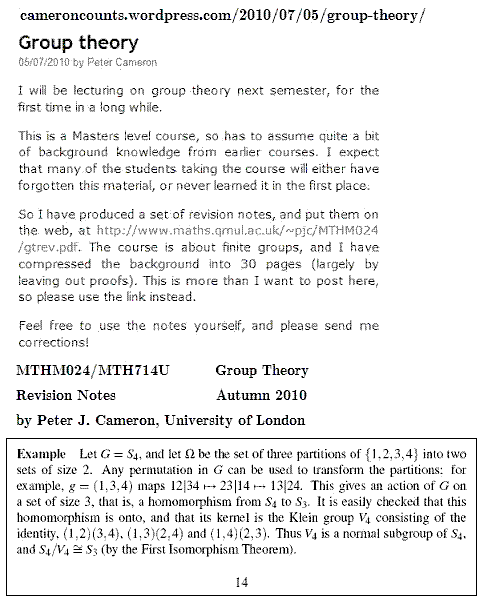Yesterday's excerpt from von Balthasar supplies some Catholic aesthetic background for Galois geometry.
That approach will appeal to few mathematicians, so here is another.
Euclid's Window: The Story of Geometry from Parallel Lines to Hyperspace is a book by Leonard Mlodinow published in 2002.
More recently, Mlodinow is the co-author, with Stephen Hawking, of The Grand Design (published on September 7, 2010).
A review of Mlodinow's book on geometry—
"This is a shallow book on deep matters, about which the author knows next to nothing."
— Robert P. Langlands, Notices of the American Mathematical Society, May 2002
The Langlands remark is an apt introduction to Mlodinow's more recent work.
It also applies to Martin Gardner's comments on Galois in 2007 and, posthumously, in 2010.
For the latter, see a Google search done this morning—

Here, for future reference, is a copy of the current Google cache of this journal's "paged=4" page.
Note the link at the bottom of the page in the May 5, 2010, post to Peter J. Cameron's web journal. Following the link, we find…
For n=4, there is only one factorisation, which we can write concisely as 12|34, 13|24, 14|23. Its automorphism group is the symmetric group S4, and acts as S3 on the set of three partitions, as we saw last time; the group of strong automorphisms is the Klein group.
This example generalises, by taking the factorisation to consist of the parallel classes of lines in an affine space over GF(2). The automorphism group is the affine group, and the group of strong automorphisms is its translation subgroup.
See also, in this journal, Window and Window, continued (July 5 and 6, 2010).
Gardner scoffs at the importance of Galois's last letter —
"Galois had written several articles on group theory, and was
merely annotating and correcting those earlier published papers."
— Last Recreations, page 156
For refutations, see the Bulletin of the American Mathematical Society in March 1899 and February 1909.

















